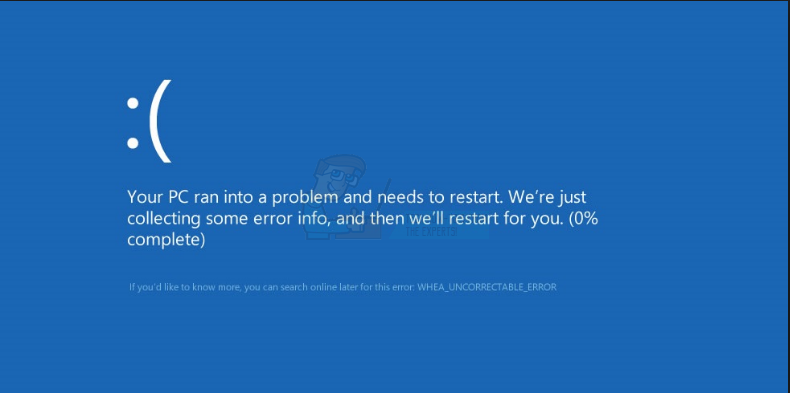How to Fix WHEA_UNCORRECTABLE_ERROR on Windows 7, 8 and 10
A BSOD (Blue Screen of Death) represents a worst-case scenario caused by an error while using Windows, as it restricts your accessibility and can be fatal if not resolved within a specific time period. One such error is the WHEA_CORRECTABLE_ERROR, which usually presents with a check value of 0x00000124. As the name suggests, this error is not an ordinary one because it often occurs due to hardware failure, which is, in most cases, uncorrectable by Windows itself. There may also be several other reasons causing this problem on your PC, and they are listed below.

Major Causes of WHEA_CORRECTABLE_ERROR
As mentioned above, there might be several other reasons behind this error.
- Corrupted or incorrectly configured Device Drivers can also be responsible for this kind of problem.
- Faulty RAM or a hard drive is a type of hardware failure, and it can be problematic if not resolved properly.
- Over-clocking the CPU might increase the amount of heat produced causing your PC to destabilize and throw this error.
- Windows Update failure can also lead you to this problem in some cases.
Solutions to Fix WHEA_CORRECTABLE_ERROR:
Based on the kind of factor causing this trouble, there are a number of solutions that can help to find and resolve this problem.
#1: Check for problem with RAM:
RAM is a major component of your computer and when it starts deteriorating, it can cause several issues. So, you are required to first check the RAM if you come across this error. To do so, follow these steps.
Due to this BSOD error, you can’t log into your Windows. Therefore, you need to boot into Safe Mode before proceeding. We have an easy, comprehensive guide for you on how to start Windows in Safe Mode.
After you have entered Safe Mode, follow the steps below.
- Windows Memory Diagnostic is a Windows tool to check and fix any issue with your RAM. Go to Start, type Windows Memory Diagnostic and open it.
- Click on the first link and let the computer run the check for you. It might take a while. At the end, if you find some errors, you’ll need to remove the RAM and insert it again, if you are using a Desktop PC or Laptop. Check for the problem again by logging into your Windows. If it still persists, you’ll need to replace your RAM with a newer one.
If this tool doesn’t show this error, then try the next solution below.
#2: Check for Corrupted Hard Disk:
To check for corruption/ bad sector in your Hard Drive, follow these steps.
- Start your Windows in Safe Mode again as mentioned earlier.
- Go to Start and type “chkdsk” to open the Check Disk Utility by Windows. You need to run it as an administrator by right-clicking on it and selecting “Run as administrator“.
- This utility tool will automatically start to identify problems with your hard drive and will attempt to fix any that are found. You can also try to resolve these issues by unplugging and then re-plugging your hard disk. If no issues are detected with your hard drive, proceed to the next method.
- Alternatively, you can download your hard drive manufacturer’s own disk healing tool to fix the problems.
#3: Update All of the Physical Device Drivers:
It is more obvious that when you have an outdated device driver, you are prone to various conflicts that can lead you to this kind of error. So, updating the drivers can definitely save you from losing your data.
- Restart your Windows in Safe Mode once again, right-click on the Start Menu icon, and select Device Manager. Update all the necessary component drivers listed there by right-clicking on each and selecting ‘Update Driver Software‘. After you finish, restart your computer in Normal Mode. In most scenarios, this should fix the WHEA_UNCORRECTABLE_ERROR BSOD error.
#4: Disable Over-Clocking if Enabled:
Overclocking actually boosts your processor’s clock speed to a certain level for the purpose of getting the most out of it. Although overclocking doesn’t typically cause problems, if your hardware isn’t compatible or overclocking surpasses certain levels, it could be extremely harmful. Therefore, if you encounter this BSOD error, you need to disable overclocking if you have implemented it.
- Restart your PC and press the relevant key assigned by your PC’s manufacturer (F8, F9, F12 etc) in order to enter BIOS.
- Inside the BIOS, navigate to ‘Advanced‘ and then to ‘Performance‘. Check if over-clocking is disabled. If it isn’t, disable it, save the changes to your settings, and then restart your PC.